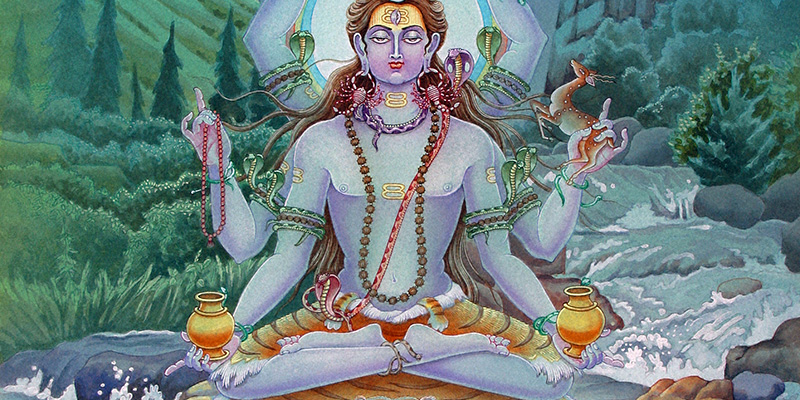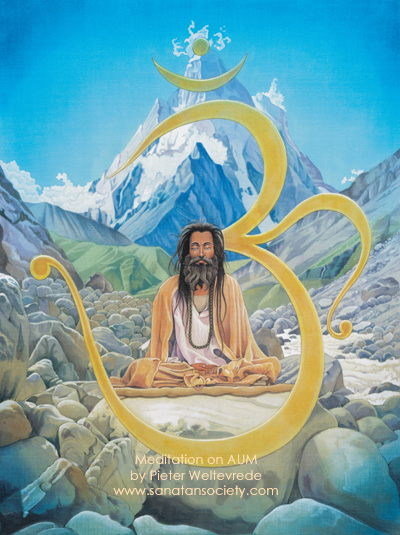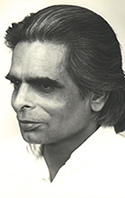To spread the original, universal and eternal truth, path or law of yoga, which remains forever the same in essence, yet always adapts to the time and place. |

There are of course a million different ways how to meditate. Yet in each technique the process of meditation is also not different in its general approach. Taking mantra meditation as an example, the following text explains all the practical do's and don't on how to meditate.
To meditate ultimately means to stop thinking long enough in order for the ego to disappear (see also Ashtanga Yoga). To stop thinking is of course not easy, yet it is also not difficult when correct understanding of the process of meditation is applied with sufficient time and patience.
As long as it is difficult to stop thinking altogether, we try to think only on one thing. Thus meditation techniques always ultimately use one object of meditation, which might be a mantra, a yantra, an image of a deity, an idea, breath, the now, etc... Through the extended focus on this object, two objectives are intended. First, we get a nice calm feeling after the meditation, which we may still experience many hours afterwards. Second, during the meditation, mind might actually fall asleep, while you are still awake. The first objective is reached from the beginning, for everyone who gives meditation a serious try without too much care for the result. The second objective usually takes a lot longer to reach. Yet it can be reached by anyone and the effects afterwards are quite miraculous.
 When learning how to meditate, we need to accept the nature of mind and not let our ego get in the way. Mind is a monkey that never sits still. It easily gets bored. If we try to forcefully focus mind on the object of meditation, mind gets bored very easily and tries to escape by bringing up all kinds of thoughts and feelings. The main trick is to gradually engage mind in the process. Will power is a requirement, yet the hard concentration only makes mind's resistance more strong. If we try to concentrate too much, then meditation becomes a really boring challenge.
When learning how to meditate, we need to accept the nature of mind and not let our ego get in the way. Mind is a monkey that never sits still. It easily gets bored. If we try to forcefully focus mind on the object of meditation, mind gets bored very easily and tries to escape by bringing up all kinds of thoughts and feelings. The main trick is to gradually engage mind in the process. Will power is a requirement, yet the hard concentration only makes mind's resistance more strong. If we try to concentrate too much, then meditation becomes a really boring challenge.
To engage mind, at first we need variety, beauty, diversity. So the object of our meditation must not be too boring at first. Mind should actually like to focus on it. Any mantra, yantra, etc... has a soothing, calming effect on mind. When we can focus mind on an entertaining version of our object of meditation, the object will start to affect mind, calming it down so it can accept a more simple, calm, less entertaining, more boring version of the object to meditate upon. That is the step by step process through which anybody can learn how to meditate.
So don't make the mistake of frustrating yourself by focusing mind too fast on just one boring object. And neither make the mistake to keep changing your focus : just gradually move towards the essential objective of being softly but firmly focused on one tiny simple thing only.
 Chose a calm, soothing environment if possible. Reduce sensory input (sound, light) if possible. Make it a private affair, if possible. If all this is not possible, it just adds to the difficulty of the exercise. The result in terms of calmness might be less, yet it may improve your skills a lot. Some yogis try to meditate in the most disturbing of places for that reason. Chosing a particularly sanctified place may be very beneficial, but of course it is no requirement. The Plane of Sanctity lies inside you. Try to avoid windy places or places where you are not feeling very safe.
Chose a calm, soothing environment if possible. Reduce sensory input (sound, light) if possible. Make it a private affair, if possible. If all this is not possible, it just adds to the difficulty of the exercise. The result in terms of calmness might be less, yet it may improve your skills a lot. Some yogis try to meditate in the most disturbing of places for that reason. Chosing a particularly sanctified place may be very beneficial, but of course it is no requirement. The Plane of Sanctity lies inside you. Try to avoid windy places or places where you are not feeling very safe.
Light some insense or use some essential oils to unify the sense of smell and purify the environment, removing disturbing energies. That last part may sound a bit strange, but just do it.
If you are feeling particularly stressed, you have the option of doing some relaxation excercises in advance of your meditation, mostly asana and pranayama excercises. Typical here is the corpse pose combined with simply slowing down breath or even stopping breath for a few seconds between inhalation and exhalation. Upon exhaling, focus on the contact with the floor. If you have more time, other asana and pranayama excercises might help to remove more stress from your body and improve the flow of energy. You might use some meditation music at this stage also, but it must go once you really start to meditate.
Sit in a comfortable posture. Keep your back relatively straight. The lotus posture is ideal, but the half lotus will also do (put the right leg upon the left leg rather than vice versa), as will the simple crosslegged posture. Use cushions or some rolled up yoga mat or blanket to support your posture and allow you to relax your legs. So, if your knees are not fully touching the floor, put something underneath to support them. Just dont give yourself too much support or you might fall asleep. If sitting is a difficult issue for you, have a look at this video clip "Asana for sitting in meditation". If during meditation you experience pain in sitting, just allow your body to readjust itself, while you remain focused on the object of your meditation.
Decide what meditation excercise you will do. This is absolutely essential. If you have no clear idea what you will do, then you will have to think about it while you meditate. It is one of the most popular ways to disturb meditation. Am I doing it right ? Should i try it another way ? If during one hour of meditation you change course once, that may still be acceptable. More is nonsense. For a meditation technique to work, it needs to be applied for some time. Evaluation is important, but only afterwards. And once you have found a technique that seems to work for you, use this technique for a long period of time, so that you dont even have to think about what you will be doing and can easily fall into a know pattern of meditation. That is how you can really learn how to meditate.
 A main thing to decide upon is the duration of the meditation. If you dont fix that somehow, you are only giving mind a million excuses for stopping the meditation prematurely. In mantra meditation, usually a mala is used to count the number of mantras, so you can decide to do one mala, two malas, etc... For real meditation, it is advisable to let the hand that counts rest on your knee, rather than holding the mala up in front.
A main thing to decide upon is the duration of the meditation. If you dont fix that somehow, you are only giving mind a million excuses for stopping the meditation prematurely. In mantra meditation, usually a mala is used to count the number of mantras, so you can decide to do one mala, two malas, etc... For real meditation, it is advisable to let the hand that counts rest on your knee, rather than holding the mala up in front.
For other kinds of meditation, other types of counting devices exist or you can simply decide to meditate for 15 mins, half an hour, one hour, three hours, etc... and use an alarm clock (or better even have some nice music starting after a set time).
Now that you know what you will do, make a promise that you will do it. That way, whatever doubt mind may produce, your ego will want to stick to this promise, because if not it will feel dissatisfied with itself afterwards. Make that promise to your divine self, or god, or whatever you believe in. It is a promise to focus for a while on that which you actually believe is important.
To meditate thus means to temporarily drop all attention from the world outside, from what happened yesterday or what will happen tomorrow. It may be usefull to remember that just before starting your meditation. Nothing but your meditation is important now. Everything else can wait.
Mantra meditation is one of the most popular meditation techniques known in all cultures and it is definitely a great way to learn how to meditate. The powerful effect of the sound syllables on both the conscious mind and the subconscious mind is a great help. Mind is literally sung to sleep and this effect is not just felt when singing the mantra out loud, but it is also present when the mantra is silently recited inside. Mantra meditation is also popular because the mantra can be used in many different ways and is thus very suited to gradually move mind from an entertaining object towards a more simple object.
The following sequence can be used by anyone, while the duration of each phase may vary. People that are just starting to learn how to meditate will put most time into the first easy phases, and less time into the later, more difficult phases. Gradually, the first phases may be done with fairly quickly, or even entirely skipped. But even people that already know how to meditate quite well, might put some more time into the first phases any day that they are feeling less calm than usual, because of life and all that. Patience is all you need and the only impatient one is the holy ego.
Phase 1 : engaging mind
At first we start the meditation by singing the mantra out loud, which anybody can do. By singing as beautifully as possible, putting some emotion into it, feeling love for the divine, any mind will be interested to assist. If you feel like it, you can even add the sound of some instrument to it, like a bell, just don't make it too exciting. Sometimes also mudras (hand postures) are used during this phase, as well as ritual acts like the offering of flowers, water, light, sweet, insense, etc.. With fairly short mantras, it is also possible to synchronize the singing with breath during this phase, though this should be discontinued as you move further inside (focus on breath is rather outside of your inside).
Maybe your environment doesn't allow for singing the mantra out loud to begin with. Then you just start from phase 2 or 3, which may be more difficult, but is really good excercise.
Phase 2 : becoming more quiet
Gradually the singing should be more simple and monotonous and we should drop the bell or whatever else we have added to fully engage mind. Then gradually also the singing should be less loud and perhaps more slow, so that our breathing rate can slow down too. This stage ends in mumbling, whispering the mantra.
During this phase it is advisable to center your attention somewhere in your body, otherwise you give mind an excuse to wander about the body and report on all kinds of things felt there. The main places in the body where you can focus are between the eyebrows (the third eye), the heart chakra and the tip of the nose.
Phase 3 : inside recitation, maybe including visualisation
Now gradually move from whispering the mantra towards reciting the mantra inside. This is definitely a difficult step for many, but fortunately also at this stage we still have many options to create the variety needed to engage mind. Even inside, we can put some emotion into our mental "singing" and make it sound beautiful. The speed at which we recite the mantra is another variable to work with, gradually moving from rather fast to rather slow, as the slower we get, the easier it is for thoughts to move in.
 One thing which works for many people during this phase is to visualize the syllables of the mantra and thus engage not just the brain hemisphere that works with sound, but also the other hemisphere that works with images. If we use only sound inside, then mind can more easily disturb our focus by bringing up some image that causes us to start thinking. Combining sound and image is thus very effective. The image of a yantra or deity can also be used together with the mantra, especially for people that are good at visualisation (like most artists). For people that are not so good at visualisation, visualising the characters of each syllable as you recite it works best. You dont need to actually see the characters in red on a neon background or something. Just catching a glimpse of them is enough effort to keep that side of your brain engaged. Seeing these characters does require relative slow recitation of the mantra.
One thing which works for many people during this phase is to visualize the syllables of the mantra and thus engage not just the brain hemisphere that works with sound, but also the other hemisphere that works with images. If we use only sound inside, then mind can more easily disturb our focus by bringing up some image that causes us to start thinking. Combining sound and image is thus very effective. The image of a yantra or deity can also be used together with the mantra, especially for people that are good at visualisation (like most artists). For people that are not so good at visualisation, visualising the characters of each syllable as you recite it works best. You dont need to actually see the characters in red on a neon background or something. Just catching a glimpse of them is enough effort to keep that side of your brain engaged. Seeing these characters does require relative slow recitation of the mantra.
Thoughts will still come. Just accept that it happens to everyone who is learning how to meditate. Don't let it frustrate you, don't think about why or how. Don't think about it at all. Whenever you notice that you are (again) thinking something, just drop it and return to the mantra. If you have to do this a hundred times during one meditation session, no problem. Gradually it will become more easy. Have faith that you can learn what anybody can learn.
Phase 4 : further simplifying the object
At some stage in learning how to meditate, you will experience that thoughts come less and less frequently. At this point, you can further try to simplify the object of your meditation, so that it becomes increasingly calm. Maybe you feel confident that you can now drop the visualisation, or slow down the speed of recitation, or recite the mantra without much emotion or beauty, etc... Gradually work your way towards the most simple and calm object of meditation.
Phase 5 : softening your focus
When that is done, there is only one thing left to do : to reduce the strength of your focus without losing the object. Let the mantra be recited by your mind, while you are simple witnessing the mantra, using minimal effort to keep it going. The final objective in meditation is to drop the doer but the doer cannot drop itself. But you can reduce the sense of doing, concentrate more softly, more calmly. That is all you can do. Do it long enough and the doing will go along with the doer and you will enter samadhi, effortless meditation (see Ashtanga Yoga).
Phase 6 : silence
However far or deep you get, when the time to meditate is over, or the mala is finished, try to keep entirely still for a moment. In fact, don't try anything. This is your best shot at feeling what it is like to stop thinking. Even if you experience inner silence only for a few seconds, it will bring you a lot. Don't be sad once your mind again starts moving - it is only natural.
After a while, the tendency to immediately move towards phase 6 may be strong. However, one should realize that a running jump takes you much further than a standing jump. Accept that to keep mind quiet for a long time works best after letting the mantra work its magic for a while.
Your time spend in trying how to meditate does not stand alone. Try to make your life more calm as well. Your meditation will help you to do that and doing that will also speed up your progress in meditation.
For mantra meditation, it is very helpful to chant the mantra inside or out loud whenever you dont need your mind for anything else. This is especially useful whenever you are engaged in non mental work, like walking, cleaning, etc... It will help to establish the neural pattern of the mantra in your brain and it will stop you from going through the same thoughts again and again. Whenever the mantra comes to your mind naturally, at least finish it once - don't break it off halfway or you might damage the neural pattern that you have already created.
The best time for meditation is sunrise, but any time will do.
A common mistake is to meditate only when you feel disturbed enough to need it. While it is natural to make that mistake at first, try to move towards more regular, daily meditation. Even if you have only 15 mins to spend, do it. When you are not feeling particularly disturbed, your meditation will be more effective and it will help to prevent future disturbances. Accept that while you are as divine as anything else, to bring out the divine into your entire being requires regular effort. Accept that it is a matter of steady growth, while the only one who can slow down this growth is the one who is impatient with the speed of it. Expect only the unexpected.
 This article on "how to meditate ?" was written by Peter Marchand, who also wrote these books : "The Yoga of the Nine Emotions" and "The Yoga of Truth".
This article on "how to meditate ?" was written by Peter Marchand, who also wrote these books : "The Yoga of the Nine Emotions" and "The Yoga of Truth". | Q&A ON MEDITATION |
Related video : Full Class - Gayatri Mantra Meditation (100')
 Sanatan Society is an international networking association of students of the late Harish Johari, joining efforts to promote his teachings of yoga philosophy, tantra, worship, art and love. Sanatan Society stands
for the original, universal and eternal truth, path or law of yoga.
Though it is Hindu in origin, Sanatan Society is not limited to any religion,
race, time or country, nor in fact to any particular organisation. More about Sanatan Society...
Sanatan Society is an international networking association of students of the late Harish Johari, joining efforts to promote his teachings of yoga philosophy, tantra, worship, art and love. Sanatan Society stands
for the original, universal and eternal truth, path or law of yoga.
Though it is Hindu in origin, Sanatan Society is not limited to any religion,
race, time or country, nor in fact to any particular organisation. More about Sanatan Society...